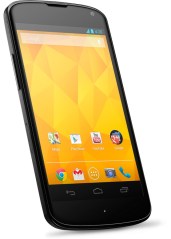The tech world has been buzzing lately about a potential wave of new “Nexus” phones. LG just announced a white Nexus 4 to complement the black model that’s already available. Samsung will release a Nexus-like version of its Galaxy S 4 next month, and HTC is rumored to be considering the same for its HTC One.
All of this news would have excited me a few months ago, when I considered myself somewhat of an Android purist. But my recent purchase of an HTC One has made me rethink whether Nexus phones can truly provide a better experience.
If you’re unfamiliar, devices that bear the “Nexus” label run Android exactly as Google intended, without frilly modifications from phonemakers. You won’t, for instance, find S-Voice or Smart Scroll — hallmark features of Samsung’s Galaxy S phones — on the company’s Nexus 10 tablet or Galaxy Nexus phone. Techies tend to like the Nexus concept because it represents a purer, dare I say Apple-like, approach to smartphone design. There are no gimmicks, and no “bloatware,” and the software updates come directly from Google without any delays.
The HTC One, which runs a modified version of Android dubbed Sense, has convinced me that the benefits of non-Nexus devices outweigh the drawbacks. After spending about three weeks with the HTC One, there are a few features I’d be reluctant to give up:
Killer Camera Software: On the HTC One, the camera is the killer app. I love the ability to hold down the shutter button to take photos in burst mode, and then select the best photo of the bunch to save. HDR mode is easy to access, and the ability to snap photos from a video is a nice touch. The camera software on Nexus devices isn’t as advanced, nor is it designed with any particular hardware in mind. Putting stock Android on the HTC One would make the camera worse.
Lock-Screen Shortcuts: On HTC’s phones, you can jump directly into any of your docked apps from the lock screen by swiping up on the app icon. On my phone, I have quick access to voice search, Chrome, Gmail and the camera. Nexus devices have camera and Google shortcuts on the lock screen, but that’s it.
IR Blaster: The HTC One has a built-in infrared transmitter, which allows the phone to double as a TV and stereo remote. I no longer have to juggle multiple remotes, and the TV app’s built-in channel guide is a huge help for over-the-air broadcasts since we don’t have cable. To date, no Nexus device includes an IR blaster, and Google doesn’t offer any of its own software to take advantage.
I don’t have as much experience with Samsung’s Galaxy S 4, but you could make the same case based on that phone’s features. The S 4, for instance, has its own IR blaster and a few helpful camera modes.
Meanwhile, the things that used to irk me about non-Nexus devices aren’t as problematic anymore:

Google’s Android Update Workaround: During Google’s I/O conference this month, Dustin Earley at Android and Me made the sharp observation that Google is updating Android without updating Android. New features like Google Play Music All Access and Google Play Game Services are available to a wide range of phones without the latest version of Android. Same goes for updated versions of Google Maps, Google Now and the revamped Google Hangouts app (formerly Google Talk). Essentially, Google is working around the fact that phonemakers and wireless carriers are slow to upgrade their devices. So while my HTC One runs Android 4.1, rather than the latest Android 4.2, the experience doesn’t suffer much.
Resources to Spare: In the past, you could feel the tweaks from HTC and Samsung bogging down the Android software on their phones. Animations were often sluggish or intrusive, and scrolling was choppy and laggy. But thanks to advances in smartphone hardware, as well as Google’s own work in making Android slicker, I’ve found that most new Android phones run smoothly no matter what. Phonemakers have room to add features without hogging vital resources.
There are still things I prefer about the Nexus experience. Aesthetically, Google’s software design is much slicker than anything I’ve seen from HTC, Samsung or LG, and I like how Nexus devices use software buttons instead of hardware keys for home, back and multitasking. Also, bloatware is still a nuisance on non-Nexus phones, especially on AT&T. My HTC One is larded up with all kinds of unwanted apps and services, like AT&T’s Navigator and Address Book, and some of them can’t be removed or disabled.
The Nexus program still serves a purpose beyond appealing to consumers. It’s a way for Google to show off the latest version of Android and to provide a reference device for developers and phonemakers. But Google has also tried to sell the Nexus brand to the masses by offering low-cost unlocked phones and cheap tablets. At least in the U.S., carrier-subsidized phones are cheaper and easier to acquire, so the need for Nexus phones isn’t as pronounced.
Still, in the past I’ve hoped for just the right Nexus hardware to come along, so I could finally get the best Android software experience possible. Only now, phonemakers like HTC are doing a better job at Android than Google.

